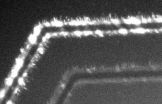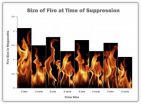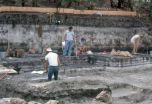(Press-News.org) A research and development effort by the University of Notre Dame, the University of Wyoming, and Kraig Biocraft Laboratories, Inc. has succeeded in producing transgenic silkworms capable of spinning artificial spider silks.
"This research represents a significant breakthrough in the development of superior silk fibers for both medical and non-medical applications," said Malcolm J. Fraser Jr., a Notre Dame professor of biological sciences. "The generation of silk fibers having the properties of spider silks has been one of the important goals in materials science."
Natural spider silks have a number of unusual physical properties, including significantly higher tensile strength and elasticity than naturally spun silkworm fibers. The artificial spider silks produced in these transgenic silkworms have similar properties of strength and flexibility to native spider silk.
Silk fibers have many current and possible future biomedical applications, such as use as fine suture materials, improved wound healing bandages, or natural scaffolds for tendon and ligament repair or replacement. Spider silk-like fibers may also have applications beyond biomedical uses, such as in bulletproof vests, strong and lightweight structural fabrics, a new generation athletic clothing and improved automobile airbags.
Until this breakthrough, only very small quantities of artificial spider silk had ever been produced in laboratories, but there was no commercially viable way to produce and spin these artificial silk proteins. Kraig Biocraft believed these limitations could be overcome by using recombinant DNA to develop a bio-technological approach for the production of silk fibers with a much broader range of physical properties or with pre-determined properties, optimized for specific biomedical or other applications.
The firm entered into a research agreement with Fraser, who discovered and patented a powerful and unique genetic engineering tool called "piggyBac". PiggyBac is a piece of DNA known as a transposon that can insert itself into the genetic machinery of a cell.
"Several years ago, we discovered that the piggyBac transposon could be useful for genetic engineering of the silkworm, and the possibilities for using this commercial protein production platform began to become apparent."
Fraser, with the assistance of University of Wyoming researcher Randy Lewis, a biochemist who is one of the world's foremost authorities on spider silk, and Don Jarvis, a noted molecular geneticist who specializes in insect protein production, genetically engineered silkworms in which they incorporated specific DNAs taken from spiders. When these transgenic silkworms spin their cocoons, the silk produced is not ordinary silkworm silk, but, rather, a combination of silkworm silk and spider silk. The genetically engineered silk protein produced by the transgenic silkworms has markedly improved elasticity and strength approaching that of native spider silk.
"We've also made strides in improving the process of genetic engineering of these animals so that the development of additional transgenics is facilitated," Fraser said. "This will allow us to more rapidly assess the effectiveness of our gene manipulations in continued development of specialized silk fibers."
Since silkworms are already a commercially viable silk production platform, these genetically engineered silkworms effectively solve the problem of large scale production of engineered protein fibers in an economically practical way.
"Using this entirely unique approach, we have confirmed that transgenic silkworms can be a potentially viable commercial platform for production of genetically engineered silk proteins having customizable properties of strength and elasticity," Fraser said. "We may even be able to genetically engineer fibers that exceed the remarkable properties of native spider silk."
The genetic engineering breakthrough was announced today (Sept. 29) by Fraser, Lewis and Kraig Biocraft CEO Kim Thompson at a press conference on the Notre Dame campus.
###
Contact: Malcolm J. Fraser Jr., 574-631-6209, fraser.1@nd.edu
Notre Dame and Wyoming scientists genetically engineer silkworms to produce artificial spider silk
2010-09-30
ELSE PRESS RELEASES FROM THIS DATE:
CEO's fate in hands of external constituents
2010-09-30
A CEO's fate might be in the hands of external constituents, according to a new study from Rice University's Jones Graduate School of Business. The study found that investment analysts and their negative stock ratings can sway a board to dismiss its CEO.
Conventional research has focused on internal factors that contribute to CEO dismissal -- poor firm performance and organization power and politics. But the new study, published by the Strategic Management Journal, turned its attention outward to discover the significant influence investment analysts have on a board ...
NRL's Wide-Field Imager selected for Solar Probe Plus mission
2010-09-30
NASA has chosen the Naval Research Laboratory's (NRL's) Wide-field Imager to be part of the Solar Probe Plus mission slated for launch no later than 2018. The Solar Probe Plus, a small car-sized spacecraft will plunge directly into the sun's atmosphere approximately four million miles from our star's surface. It will explore a region no other spacecraft ever has encountered in an effort to unlock the sun's biggest mysteries.
For decades, scientists have known that the corona, or the outer atmosphere, is several hundreds of times hotter than the visible solar surface ...
New NIST 'standard cigarette' available for fire-resistance testing
2010-09-30
Cigarettes are the most frequent cause of fatalities from residential fires in the United States. So, it might seem surprising to learn that a cigarette that burns stronger than others has been used for decades by manufacturers of home furnishings to test the fire resistance of their products. Making certain that they can continue this life- and property-saving effort is the job of a new standard reference material (SRM) from the National Institute of Standards and Technology (NIST).
NIST SRM 1196, "Standard Cigarette for Ignition Resistance Testing," consists of 10 packs ...
Studies show improved patient tolerance for unsedated colonoscopy using novel water method
2010-09-30
OAK BROOK, Ill. – September 29, 2010 – The October issue of GIE: Gastrointestinal Endoscopy, the monthly peer-reviewed scientific journal of the American Society for Gastrointestinal Endoscopy (ASGE), features the results of two randomized controlled trials of unsedated colonoscopy comparing water infusion versus air insufflation to distend the colon. Both studies showed that patient tolerance with the water method during unsedated colonoscopy was greater than with air insufflation and enhanced patient willingness to undergo a repeat unsedated exam; however, the cecal intubation ...
Growing nanowires horizontally yields new benefit: 'nano-LEDs'
2010-09-30
While refining their novel method for making nanoscale wires, chemists at the National Institute of Standards and Technology (NIST) discovered an unexpected bonus—a new way to create nanowires that produce light similar to that from light-emitting diodes (LEDs). These "nano-LEDs" may one day have their light-emission abilities put to work serving miniature devices such as nanogenerators or lab-on-a-chip systems.
Nanowires typically are "grown" by the controlled deposition of molecules—zinc oxide, for example—from a gas onto a base material, a process called chemical vapor ...
NIST 'Vision Science Facility' aims for lighting revolution
2010-09-30
Light-emitting diodes, or LEDs, have become popular with backpackers and cyclists who mount them on headbands for a reliable, hands-free source of illumination. Now, a new lab at the National Institute of Standards and Technology (NIST) is helping to bring these tiny but brilliant devices into your home, to help save both energy costs and the environment.
"LEDs can be very energy efficient, and they are a lot smaller and last a lot longer than light bulbs," says NIST vision scientist Wendy Davis. "They're what we'll likely use in the future to light our houses and public ...
Children's well-being and varying degrees of family instability
2010-09-30
Bowling Green, OH—September 29, 2010— A forthcoming issue of the Journal of Marriage and Family states that children today are less likely to be born into a "traditional" family structure, defined as two biological married parents. Growing numbers of children in the United States experience multiple family living arrangements during childhood. How these transitions affect the individual child's well-being needs to be fully addressed by researchers and policymakers alike. This article fully reviews the existing research from the past ten years on these topics in an effort ...
NIST residential fire study education kit now available
2010-09-30
Researchers from the National Institute of Standards and Technology (NIST) and the International Association of Fire Fighters have prepared an educational resource for fire chiefs, firefighters, and public officials to summarize and explain the key results of a landmark study on the effect of the size of firefighting crews on the ability of the fire service to protect lives and property in residential fires.
The study, Report on Residential Fireground Field Experiments, was published by NIST last April. The study is the first to quantify the effects of crew sizes and ...
MD Anderson study finds increases in 5-, 10-year survival at every stage of breast cancer
2010-09-30
VIDEO:
This study finds higher survival rate at every stage of breast cancer.
Click here for more information.
HOUSTON - Advances in screening for disease detection, better surgical techniques available to more women, and an increased number of therapies that reduce the risk of relapse in patients with both locally advanced and early stage disease, have collectively contributed to dramatic improvements in breast cancer's survival rates, according to a review of 60 years ...
No evidence for Clovis comet catastrophe, archaeologists say
2010-09-30
New research challenges the controversial theory that an ancient comet impact devastated the Clovis people, one of the earliest known cultures to inhabit North America.
Writing in the October issue of Current Anthropology, archaeologists Vance Holliday (University of Arizona) and David Meltzer (Southern Methodist University) argue that there is nothing in the archaeological record to suggest an abrupt collapse of Clovis populations. "Whether or not the proposed extraterrestrial impact occurred is a matter for empirical testing in the geological record," the researchers ...



